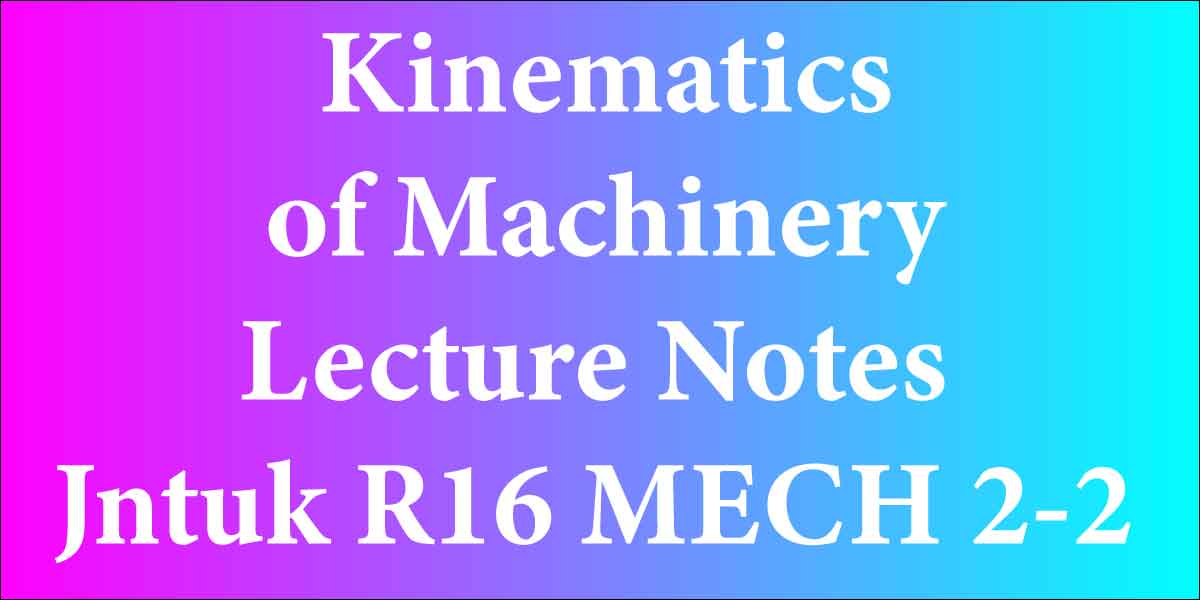Kinematics of Machinery
Objective:
The scholars finishing this course square measure expected to grasp the character and role of the mechanics of machinery, the mechanisms and machines. The course includes speed and acceleration diagrams, analysis of mechanisms joints, Cams and their applications. It exposes the scholars to varied forms of power transmission devices like belt, rope , chain and equipment drives and their operating principles and their deserves and demerits.
UNIT – I
Objective: the target of this unit is to form student perceive the aim of mechanics, Kinematic joint and mechanism and to check the relative motion of elements in a very machine while not taking into thought the forces concerned. MECHANISMS : parts or Links – Classification – Rigid Link, versatile and fluid link – forms of kinematic pairs – slippery , turning, rolling, screw and spherical pairs – lower and better pairs – closed and open pairs – unnatural motion – utterly, part or with success unnatural and incompletely unnatural . Grublers criterion , Grashoff’s law , Degrees of freedom, Kutzbach criterion for placoid mechanisms, Mechanism and machines – classification of machines – kinematic chain – inversion of mechanism – inversion of mechanism – inversions of curve cycle, chain – single and double slider crank chains.
UNIT – II
Objective: the target of this unit is to form student perceive numerous mechanisms for line motion and their applications as well as mechanism. LOWER combine MECHANISM: precise and approximate copiers and generated sorts – Peaucellier, Hart and Scott Russel – Grasshopper – Watt T. Chebicheff and Henry M. Robert Mechanisms and line motion, Pantograph. Conditions for proper steering – Davis gear, Ackermans gear – speed ratio; Hooke’s Joint: Single and double – Universal coupling–application–problems.
UNIT – III
Objective : the target of this unit is to form student perceive the speed and acceleration ideas and therefore the methodology mistreatment graphical strategies and principles and application of 4 bar chain. to grasp the appliance of slider crank mechanism etc. and study of plane motion of the body KINEMATICS: speed and acceleration – Motion of a link in machine – Determination of speed and acceleration diagrams – Graphical methodology – Application of relative speed methodology four bar chain. speed and acceleration analysis of for a given mechanism, Kleins construction, Coriolis acceleration, determination of Coriolis element of acceleration.
Plane motion of body: fast centre of rotation, centroids and axodes – relative motion between 2 bodies – 3 centres in line theorem – Graphical determination of fast centre, diagrams for straightforward mechanisms and determination of angular speed of points and links.
II Year – II Semester
L T P C
4 0 0 3
KINEMATICS OF MACHINERY
UNIT – IV
Objective: the target of this unit is to form student perceive the theories concerned in cams. any the scholars square measure exposed to the applications of cams and their operating principles. CAMS Definitions of cam and followers – their uses – forms of followers and cams – language –Types of follower motion: Uniform speed, easy periodic motion and uniform acceleration and retardation. most speed and most acceleration throughout outward and come strokes within the higher than three cases. Analysis of motion of followers: Roller follower – circular cam with straight, saclike and protrusive flanks.
UNIT – V
Objective: the target of this unit is to form student perceive gears, power transmission through differing types of gears as well as gear profiles and its potency. GEARS Higher pairs, friction wheels and toothed gears–types – law of train, condition for constant speed quantitative relation for transmission of motion, type of teeth: rounded and involute profiles. speed of slippery – phenomena of interferences – strategies of interference. Condition for minimum variety of teeth to avoid interference, expressions for arc of contact and path of contact – Introduction to coiled, Bevel and worm train.
UNIT – VI
Objective: the target of this unit is to form student perceive numerous power transmission mechanisms and methodologies and dealing principles. Students square measure exposed to deserves and demerits of every drive.
Power Transmissions : Introduction, Belt and twine drives, choice of belt drive- forms of belt drives,V-belts, materials used for belt and twine drives, speed quantitative relation of belt drives, slip of belt, creep of belt, tensions for flat belt drive, angle of contact, centrifugal tension, most tension of belt, Chains- length, angular speed quantitative relation, classification of chains.
Introduction to gear Trains, Train worth, sorts – easy and reverted wheel train – cogwheel Train. strategies of finding train worth or speed quantitative relation – cogwheel trains. choice of substances box-Differential gear for associate automobile.
Text Books:
- Mechanism and Machine Theory by Ashok G. Ambekar, letter Publishers two. Theory of Machines – S. S Rattan- TMH three. Theory of machines and Mechanisms – J.J Uicker, G.R.Pennock & J.E.Shigley – Oxford publishers.
References:
1. Theory of Machines saddhu Singh, Pearsons Edn
2. Theory of machines and Machinery /Vickers /Oxford .
3. Theory of Machines by Thomas Bevan/ CBS
4. mechanics of Machinery through Hyper Works – J.S. Rao – Springer Publ
5. Theory of Mechanisms and machines – A.Ghosh & A.K.Malik – East West Press Pvt. Ltd.

